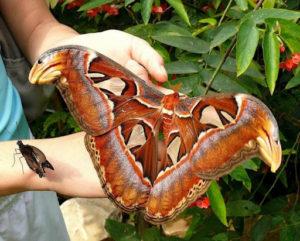Moth of the Atlas family: a giant beautiful butterfly
The largest moth belongs to the Atlas peacock-eye family. There is a version that this giant insect got its name from the epic hero of Ancient Greece - Atlas, who has remarkable strength and holds the sky.
Photo butterfly Atlas
Appearance and habitat
Name: Peacock-eye Atlas
Latin: attacus atlasClass: Insects - Insecta
Squad: Lepidoptera - Lepidoptera
Family: Peacock-eyes - Saturniidae
 | Habitats: | tropics and subtropics |
 | Dangerous for: | not dangerous |
 | Practical benefits: | cultural species that produces silk |
One of the largest butterflies in the world is found:
- in the south of China;
- Malaysia;
- India;
- Thailand;
- Indonesia;
- in the foothills of the Himalayas.
A distinctive feature of the moth is the wings, the span of which in females is a square and is 25-30 cm. In males, the rear pair of wings is somewhat smaller than the front and, when turned, looks more like a triangle.
The memorable coloration of the wings in individuals of both sexes is similar. The central part of the wing of a darker color is located on a general brown background, reminiscent of the scales of a snake. Along the edges there are light brown stripes with a black border.
The edge of each wing of the female has a bizarre curved shape and, according to the pattern, imitates the head of a snake with eyes and a mouth. This color performs a protective function - it scares off predators.
The insect is valued for the production of faghar silk thread. Peacock-eye silk is brown, durable, resembling wool. In India, the Atlas moth is cultivated.
Life
The lifestyle of females and males of the Atlas moth is different. A large female is difficult to move from the place of pupation. Its main task is to reproduce offspring. Males, on the contrary, are in constant motion, in search of a partner for mating. The wind helps them find an individual of the opposite sex, emitting odorous substances to attract a partner.
Adult insects do not live long, up to 2 weeks. They do not need food, they do not have a developed oral cavity. They exist due to the nutrients obtained during the development of the caterpillar.
About a month later, the pupation process begins: the caterpillar weaves a cocoon and, for safety reasons, hangs it from one side to the leaves. Then the chrysalis turns into a butterfly, which, having dried out a little and spread its wings, is ready to fly and mate.

Moth of Atlas.
Conclusion
The populations of the largest Atlas moth require protection. Human-consumer actively destroys these amazing insects because of cocoons, threads of fagarov silk. It is urgent to list the butterfly in the World Red Book and take all measures to protect it.
